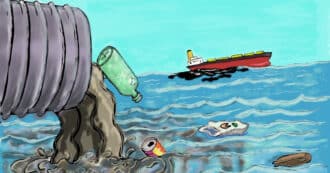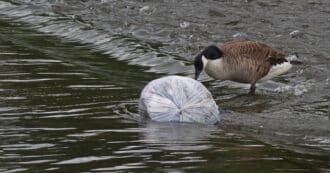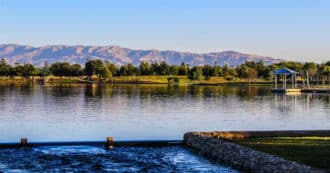By Sydney Cohen – One of the most alarming things happening in our oceans is coral bleaching. Although this phenomenon has been observed for decades, recent studies have shown that it’s becoming more frequent and lasting longer. Coral reefs are home to 25% of all marine life on Earth, so, if they die off, we’ll experience a major extinction event! Coral reefs are very important.
So what causes this coral bleaching? It turns out there are many factors responsible for this terrible environmental problem.
Coral Reefs
Coral reefs are coral formations that lie in shallow waters. The coral polyps produce a hard, calcareous skeleton and form extensive coral reef structures. Coral reefs are among the most diverse ecosystems on Earth which attract tourists to see their dazzling colors and shapes.
Scientists estimate that coral reefs cover about 10% of the world’s seafloor area but the world’s coral reefs have been disappearing at an alarming rate and experiencing bleaching events due to climate change and global warming (causing rising ocean temperatures), pollution from sewage runoff, overfishing of fish species important for food security, tourism development and other human activities such as anchoring or dredging.
Coral Bleaching
Coral bleaching is a term used to describe the loss of color from coral. Coral lives in symbiosis with algae called zooxanthellae. When their relationship becomes disrupted, the coral loses its vibrant colors and turns white, hence “bleached.”
What Happens When a Coral Reef is Bleached?
Rising water temperatures cause the coral polyps to expel their microscopic algae, known as zooxanthellae. Without the zooxanthellae, the polyps have a much harder time collecting food and absorbing the nutrients that the coral colonies need to survive.
The Great Barrier Reef
The Great Barrier Reef is the world’s largest coral reef, and it is located off the coast of Queensland in Australia. This massive structure stretches for 2,300 kilometers (1,400 miles) across the continental shelf.
The Great Barrier Reef was declared a World Heritage Site by UNESCO in 1981 due to its exceptional beauty and uniqueness. For an idea of how big it is, the Great Barrier reef covers 133,000 square kilometers (which is about the size of Italy).
The Great Barrier Reef is also one of the most important ecosystems on Earth. It’s so vast that it can be seen from space! Coral reefs support some 27 different types of marine life including whales, dolphins, sea turtles, and manta rays.
However, this ecological wonder has been threatened and damaged by climate change and pollution in recent years. It has been subject to massive bleaching events as a result of climate change that causes rising water temperatures and ocean acidification, damage from low tides, and decreased water quality from trash and pollution.
How The Great Barrier Reef Bleached
Over 2016 and 2017, The Great Barrier Reef suffered back-to-back bleaching leaving half of the shallow water corals dead. A combination of two severe bleaching events: Cyclone Debbie and outbreaks of coral-eating starfish, are substantially affecting the health of the Great Barrier Reef.
A further estimated 20% of corals were killed in the 2017 bleaching incident which moved south further from Port Douglas to Townsville. To compound the situation further, a Category 4 cyclone ravaged the Whitsundays destroying reefs that lie beneath its shoreline.
Religion and Coral Bleaching
In “A Pastoral Letter on the Great Barrier Reef,” the Catholic Bishops of Queensland discuss the disaster of widespread coral bleaching from climate change and other threats to the Great Barrier Reef. In response, the Bishops call for a “candid examination of lifestyle choices, a realization that creation is sacred and endangered and a radical change of heart – an ‘ecological conversion’
Pope John Paul II’s Ecclesia in Oceania is quoted in the letter as he describes our “special responsibility to assume, on behalf of all humanity, stewardship of the Pacific Ocean, containing over half of the Earth’s total supply of water. The continued health of this and other oceans is crucial for the welfare of peoples, not only in Oceania but in every part of the world.”
According to an article in Evangelical Focus:
Despite the very small size of each individual organism, the only animals that can be detected from space are corals, and the huge extensions of diatomaceous algae. Their apparent fragility is more than compensated for by the tenacity with which they can build reefs of more than two thousand kilometers in length. The secret of corals’ success lies in their solidarity. The union of millions of individuals is the source of the spectacular strength of their constructions.
Religious believers can draw inspiration from the humble coral, which may be tiny as an individual organism, but united, they are enormous. We too are small as individuals, but we can band together around the world to protect coral reefs, protect the oceans and protect all of Creation.
Can Coral Recover from Bleaching?
The future of coral life depends on what levels of emissions continue burning fossil fuel and which species will cause bleaching to occur. If we continue at our current rate of global warming, it would be catastrophic for coral reefs as they would not be able to recover.
In order to stop global warming, we must urgently reduce carbon emissions and limit the rise of global temperatures. It may take decades for corals to fully recover from bleaching events, so it is important that these events do not occur regularly.
* Featured image source







